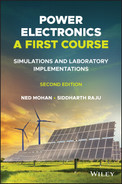POWER ELECTRONICS A FIRST COURSE Enables students to understand power electronics systems, as one course, in an integrated electric energy systems curriculum Power Electronics A First Course provides instruction on fundamental concepts related to power electronics to undergraduate electrical engineering students, beginning with an introductory chapter and moving on to discussing topics such as switching power-poles, switch-mode dc-dc converters, and feedback controllers. The authors also cover diode rectifiers, power-factor-correction (PFC) circuits, and switch-mode dc power supplies. Later chapters touch on soft-switching in dc-dc power converters, voltage and current requirements imposed by various power applications, dc and low-frequency sinusoidal ac voltages, thyristor converters, and the utility applications of harnessing energy from renewable sources. Power Electronics A First Course is the only textbook that is integrated with hardware experiments and simulation results. The simulation files are available on a website associated with this textbook. The hardware experiments will be available through a University of Minnesota startup at a low cost. In Power Electronics A First Course, readers can expect to find detailed information on: Power Electronics A First Course is an ideal textbook for Junior/Senior-Undergraduate students in Electrical and Computer Engineering (ECE). It is also valuable to students outside of ECE, such as those in more general engineering fields. Basic understanding of electrical engineering concepts and control systems is a prerequisite.
Table of Contents
- Cover
- Title page
- Copyright
- Dedication
- LIST OF SIMULATION AND HARDWARE IMPLEMENTATION EXAMPLE AND FIGURES
- PREFACE
- ACKNOWLEDGMENT
- ABOUT THE COMPANION WEBSITE
- CHAPTER 1 POWER ELECTRONICS: AN ENABLING TECHNOLOGY
- CHAPTER 2 DESIGN OF SWITCHING POWER-POLES
- CHAPTER 3 SWITCH-MODE DC-DC CONVERTERS: SWITCHING ANALYSIS, TOPOLOGY SELECTION, AND DESIGN
- CHAPTER 4 DESIGNING FEEDBACK CONTROLLERS IN SWITCH-MODE DC POWER SUPPLIES
- CHAPTER 5 RECTIFICATION OF UTILITY INPUT USING DIODE RECTIFIERS
- CHAPTER 6 POWER-FACTOR-CORRECTION (PFC) CIRCUITS AND DESIGNING THE FEEDBACK CONTROLLER
- CHAPTER 7 MAGNETIC CIRCUIT CONCEPTS
- CHAPTER 8 SWITCH-MODE DC POWER SUPPLIES
- CHAPTER 9 DESIGN OF HIGH-FREQUENCY INDUCTORS AND TRANSFORMERS
- CHAPTER 10 SOFT-SWITCHING IN DC-DC CONVERTERS AND HALF-BRIDGE RESONANT CONVERTERS
- CHAPTER 11 APPLICATIONS OF SWITCH-MODE POWER ELECTRONICS IN MOTOR DRIVES, UNINTERRUPTIBLE POWER SUPPLIES, AND POWER SYSTEMS
- CHAPTER 12 SYNTHESIS OF DC AND LOW-FREQUENCY SINUSOIDAL AC VOLTAGES FOR MOTOR DRIVES, UPS, AND POWER SYSTEMS APPLICATIONS
- CHAPTER 13 THYRISTOR CONVERTERS
- CHAPTER 14 UTILITY APPLICATIONS OF POWER ELECTRONICS
- Index
- End User License Agreement
